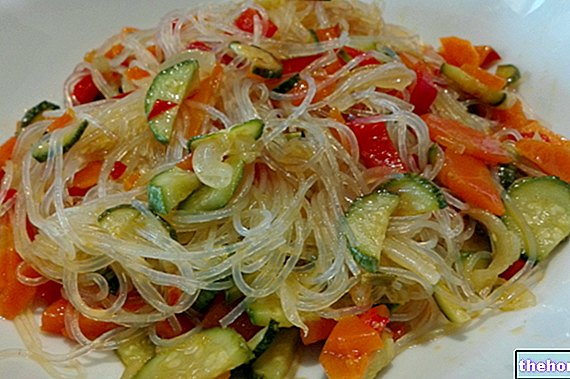Theoretical introduction
Today we will put Greek yogurt under the magnifying glass, a dairy product that can be considered a cross between a classic yogurt and a soft cheese. In this totally theoretical lesson, we will analyze the most interesting nutritional aspects of Greek yogurt and its uses. in the kitchen. In the next video we will see how to easily prepare it at home.
What is that?
Greek yogurt, also called labneh, has a very pleasant, fresh taste and has a velvety texture that is pleasant to the palate. It can be eaten as it is or flavored with honey, sugar or spices.
How is it prepared?
Greek yogurt is nothing more than a drained yogurt. It is therefore no coincidence that, in English, this particular dairy product is also called "strained yogurt", which literally means "filtered yogurt". The starting material is therefore a simple yogurt that is left to drain through a cotton cloth or a sterile gauze for a few hours. By doing this, it is possible to obtain a denser and more compact yogurt, with a lower quantity of water and a higher concentration of proteins (caseins). Most of the whey protein is removed. Most of the time, Greek yogurt is prepared from a yogurt made with cow's milk enriched in lactic ferments. To obtain a creamier and more caloric Greek yogurt, it is conceivable to add a part of cream or milk powder.
The acid serum
The liquid that drips from the raw material - called "acid serum" - is composed of water, lactic ferments, whey proteins, lactose (traces) and lactic acid.
CURIOSITY ": acid whey is sometimes used by industries as a source of methane, which in turn is used to produce electricity. Some farmers also use acid whey for the preparation of fertilizers and fertilizers.
Nutritional analysis There are different types of Greek yogurt, distinguished mainly by the amount of fat:
- 0% fat Greek yogurt: provides 52 Kcal / 100 g (9 g of protein, 4 g of carbohydrates and 0 g of fat). Particularly suitable for those who train
- Greek yogurt 2% fat
- Greek yogurt 9% fat: provides 115 Kcal / 100 g (6.4 g of proteins, 2 g of carbohydrates and 9 g of lipids)
Contains minerals such as calcium (150 mg), potassium (150 mg), phosphorus (130 mg), sodium (71 mg).
Greek yogurt in the kitchen
Due to its particular compact structure, Greek yogurt lends itself to the preparation of many recipes! For example, it represents the main ingredient of tzatziki sauce, a thick sauce flavored with cucumber, suitable for flavoring salads but also excellent for spreading on Arabic bread (pita). In some countries (eg Turkey), Greek yogurt is sometimes used as a substitute for mascarpone. In the US and Canada, Greek yogurt is used just like sour cream! In other countries, such as Israel, Greek yogurt is drained from the whey to such an extent that it is used as a soft cheese.
If I've made your mouth water, then follow me in my next video: I'll show you how it's easy to make it at home!
Presentation of the Practical Video
What do you get by squeezing (literally) any type of yogurt? Don't worry, I'm not inventing a bizarre food! Today I will show you how incredibly easy it is to make the now famous Greek yogurt at home, while saving some money! Let's find out together!
Video of the Recipe
Problems with playing the video? Reload the video from youtube.
Identity Card of the Recipe
- 112 KCal Calories per serving
-
Ingrediants
Ingredients to obtain about 200 g of Greek yogurt
- Homemade food: 500 g of yogurt
Materials Needed
- Clean tea towel
- Colander
- Bowl
- Spoons
- Jar for storage
Preparation
Please note
To prepare the Greek yogurt we used a homemade yogurt (starting from whole cow's milk and lactic ferments). However, it is also possible to use a low-fat yogurt or a yogurt prepared with sheep's milk.- Prepare the yogurt following the instructions on THIS VIDEO.
- Now prepare a bowl, preferably high, narrow and large. Place a colander over the bowl and line it with a clean cloth (which does not smell of detergent) or with a double-layered sterile gauze. It is recommended that the strainer does not come into direct contact with the liquid that will drip from the yogurt.
How to clean the tea towel thoroughly?
To prevent the dishcloth from smelling of detergent, it must be boiled in water and baking soda for about ten minutes. After that, the tea towel must be boiled again in clean water (without baking soda), then wrung out and left to dry.- Pour the plain yogurt directly into the colander lined with the cloth: close the flaps in a bundle and let it drip slowly for 4-8 hours, remembering that the longer the dripping time is prolonged, the more compact the Greek yogurt will be.
- After 4-8 hours, the Greek yogurt is ready: the bowl will have collected the dripping liquid (acid serum), while the Greek yogurt will be contained in the cloth. From 500 g of plain yogurt it is possible to obtain about 180-200 g of Greek yogurt.
Alice's comment - PersonalCooker
What did I tell you? Seen how "is it easy to prepare Greek yogurt at home? This dairy product lends itself to the creation of countless recipes: you can taste it as a dessert perhaps with honey or agave syrup, but it is also special for preparing accompanying sauces such as Tzatziki sauce! Still, Greek yogurt can turn into an excellent substitute for mascarpone, cooking cream have fun in the kitchen to create new imaginative dishes with Greek yogurt.Nutritional values and Health Comment on the recipe
Considering that from 500 grams of whole yogurt we obtained about 180 grams of Greek yogurt, one could expect that the nutritional value of the latter is 75% higher. However, a certain percentage of protein is also found in the whey lost by dripping. and lactose, which is difficult to quantify, which is why the indirect calculation of the calories of Greek yogurt shown on the side is completely approximate.




























